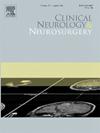帕金森病中脂联素与脂质的关系
IF 1.8
4区 医学
Q3 CLINICAL NEUROLOGY
引用次数: 0
摘要
目的越来越多的证据表明帕金森病(PD)与脂质有关,如PD脑路易体核心存在脂质或α-突触核蛋白阳性的磷酸化路易体中存在高分子量脂联素(APN)。本研究旨在验证APN水平是否与神经退行性疾病相关。研究了APN与体重的关系。材料与方法静脉血取样测定以下参数:HDL-C、LDL-C、葡萄糖和脂质,包括APN。结果接受多巴胺能治疗的spd患者APN显著高于新生PD、进行性核上性麻痹(PSP)和多系统萎缩-帕金森型(MSA-P)。ANCOVA多因素分析显示,PD治疗组与PD新生组APN水平差异有统计学意义(调整平均差异为- 4.273 μg/ml, p = 0.037),PSP患者APN水平差异有统计学意义(调整平均差异为- 4.756 μg/ml, p = 0.034)。新生PD患者的bmi指数略高于治疗后PD患者(调整后平均差异为1.686,p = 0.074)。调整后,APN水平与PD患者的hdl -胆固醇(HDL-C)呈正相关(回归系数=0.479,P <; 0.001),但与总胆固醇或LDL-C无关。这种相关性在MSA-P或PSP患者中并不明显。结论sapn可能在脂筏的组成中起作用,特别是在PD治疗患者中。APN与HDL-C之间的相关性可能是区分PD与MSA-P或PSP的标志。本文章由计算机程序翻译,如有差异,请以英文原文为准。
Association between adiponectin and lipids in Parkinson’s disease
Objectives
There is increasing evidence linking Parkinson’s disease (PD) to lipids, such as the presence of lipids in the core of Lewy bodies in PD brains or high-molecular-weight adiponectin (APN) in phosphorylated α-synuclein-positive Lewy bodies. This study aimed to verify whether APN levels are associated with neurodegenerative diseases. The association between APN and body weight was also investigated.
Materials and methods
The following parameters were measured using venous blood sampling: HDL–C, LDL-C, glucose, and lipids, including APN.
Results
PD patients receiving dopaminergic treatments had significant higher APN than that of de-novo PD, progressive supranuclear palsy (PSP) or multiple system atrophy- parkinsonian type (MSA-P). Multivariate analysis using ANCOVA revealed a significant difference in APN levels between treated PD patients and de-novo PD patients (adjusted mean difference of −4.273 μg/ml, p = 0.037]), or PSP patients (adjusted mean difference of −4.756 μg/ml, p = 0.034]). BMIs were mildly higher in de-novo PD patients compared to treated PD patients (adjusted mean difference of 1.686, p = 0.074]). After adjustment, APN levels were positively correlated with HDL-cholesterol (HDL-C) in patients with PD (regression coefficient=0.479, P < 0.001), but not total cholesterol, or LDL-C. This correlation was not evident in patients with MSA-P, or PSP.
Conclusions
APN likely plays a role in the composition of lipid rafts, particularly in patients with treated PD. The correlation between APN and HDL-C may be a marker that differentiates PD from MSA-P, or PSP.
求助全文
通过发布文献求助,成功后即可免费获取论文全文。
去求助
来源期刊

Clinical Neurology and Neurosurgery
医学-临床神经学
CiteScore
3.70
自引率
5.30%
发文量
358
审稿时长
46 days
期刊介绍:
Clinical Neurology and Neurosurgery is devoted to publishing papers and reports on the clinical aspects of neurology and neurosurgery. It is an international forum for papers of high scientific standard that are of interest to Neurologists and Neurosurgeons world-wide.
 求助内容:
求助内容: 应助结果提醒方式:
应助结果提醒方式:


